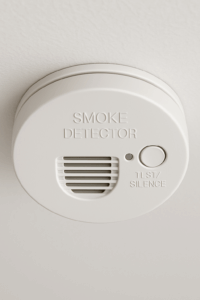Smoke detectors are crucial components of fire alarm systems, providing an early warning that can save lives and property. Understanding what smoke detectors are, how they work, and their different technologies helps ensure optimal safety for your home or business. This detailed guide from Cunningham Security covers everything you need to know.
Introduction
A smoke detector is a critical device in fire alarm systems designed to sense smoke and provide early warnings. They are often the first line of defense against fires, reducing the risk of injury, fatalities, and property damage significantly.
Purpose of Smoke Detectors
The purpose of a smoke detector in a home or commercial building is to provide early warning of smoke or potential fires, significantly enhancing occupant safety and minimizing property damage. By detecting smoke at its earliest stages, smoke detectors alert individuals to potential dangers, allowing ample time to evacuate safely and notify emergency services. Early detection is critical, as statistics consistently show that early alerts drastically reduce fire-related injuries, fatalities, and structural losses. Whether in residential or commercial settings, smoke detectors are essential components of comprehensive fire safety plans, ensuring rapid response and safeguarding both lives and property.
How Smoke Detectors Work
Smoke detectors use various sensing technologies to detect smoke particles and trigger alarms, notifying occupants of potential fires. Early detection is crucial because it significantly increases evacuation time and reduces damage.
What are Smoke Detectors Constructed From
Smoke detectors are typically constructed using durable, fire-resistant materials designed to withstand harsh conditions and high temperatures during a fire event. The outer casing is commonly made from robust thermoplastic, such as ABS (acrylonitrile butadiene styrene) or polycarbonate, due to their flame-retardant properties and ability to resist heat and impact. Internally, smoke detectors feature metal contacts and wiring made from corrosion-resistant materials like copper and brass to ensure reliable electrical performance. Sensitive electronic components, including circuit boards, sensors, and alarms, are encased securely within the unit to protect them from environmental factors, maintaining accuracy and effectiveness throughout their operational life.
Types of Smoke Detector Technologies
Ionization Smoke Detectors
Ionization detectors use radioactive material to ionize air, creating an electrical current. Smoke disrupts this current, triggering the alarm. These detectors excel at detecting flaming fires quickly.
Photoelectric Smoke Detectors
Photoelectric detectors use a light beam and sensor. Smoke scatters the beam, causing the detector to trigger. They are particularly effective at detecting slow-smoldering fires.
Dual Sensor Smoke Detectors
These combine ionization and photoelectric technologies, offering comprehensive protection against both fast-flaming and slow-smoldering fires.
Aspirating Smoke Detectors (ASD)
Aspirating detectors continuously sample air using tubes, analyzing it with highly sensitive laser detection technology. They’re ideal for environments requiring extremely early detection.
Applications for Different Smoke Detectors
- Ionization: Kitchens, laboratories, industrial areas.
- Photoelectric: Bedrooms, living rooms, hallways, offices.
- Dual Sensor: Recommended for most residential and commercial properties.
- Aspirating: Data centers, archives, warehouses, museums.
Benefits of Integrating Smoke Detectors with Fire Alarm Systems
Integration ensures quick and coordinated alerts across the entire system, improving response times and communication with emergency responders. Linked systems also facilitate automated safety responses like ventilation shutdown and unlocking exit doors.
Smoke detectors integrated into monitored fire alarm systems communicate directly with a central monitoring station, ensuring immediate response during fire emergencies. When smoke is detected, the alarm panel sends a detailed signal—via telephone lines, cellular networks, or internet connections—to the monitoring center. Operators at the central station quickly assess the incoming alerts, verify emergencies, and dispatch the local fire department promptly. This rapid communication process minimizes response time, significantly reducing the risk of extensive property damage and potential loss of life. Monitored smoke detectors thus provide an additional layer of protection, offering peace of mind that emergency responders will be alerted immediately, even when occupants are absent or unable to contact help themselves.
Maintenance and Testing
Regular testing and maintenance of smoke detectors are essential:
- Monthly battery checks and testing.
- Annual professional inspections.
- Immediate replacement of malfunctioning units.
Common Issues and Troubleshooting
Typical problems include battery depletion, dust buildup, and aging sensors causing false alarms. Routine cleaning, timely battery replacement, and professional inspections mitigate these issues. If you need to stop a smoke detector from beeping read more here.
Legal and Safety Regulations
Compliance with local fire safety codes and regulations is mandatory. Regulations often specify detector type, placement, maintenance schedules, and reporting procedures.
When to Contact Professionals
If troubleshooting doesn’t resolve issues or your system requires upgrades or certification, professional assistance ensures optimal functionality and compliance. Cunningham Security offers expert support and guidance.
Conclusion
Smoke detectors form the backbone of any robust fire alarm system. Selecting appropriate detector technologies, regular maintenance, and adherence to regulations ensure your safety. For professional installation, maintenance, or advice, contact Cunningham Security today.
For further authoritative information on smoke detection technologies, visit the National Fire Protection Association (NFPA).
